broken_arrow
New Member
Hi all,
Last October, my husband and I completed a big landscaping project in our backyard (50 trees and shrubs!), and the anchors of the landscape design are the 14 juniper trees (6-7 feet tall) that we’ve planted in various locations. We have 3 varieties: canaerti, keteleeri, and spartan.
First, I’ll explain the issues we’re having. The canaerti junipers have cedar-apple rust, which we didn’t realize when we bought them. We waited for the slimy orange galls to dry up, and earlier this week we cut off as many of the large ones as possible. In the next month or two, we’re planning to spray them with fungicide to kill off the remaining fungus. This is not the primary issue we’re concerned with, however.
While pruning off the rust galls, I noticed a lot of brown needles at the centers of all the trees (canaerti, keteleeri, and spartan). I’m not sure how much of this is normal shedding versus some other problem that needs to be corrected. The appearance of this browning varies according to juniper variety.
Here’s some background in case it helps:
These were B&B trees that were originally grown in some kind of clay soil mixture. We dug 4-foot-wide holes for each juniper and backfilled with native clay soil (amended with haydite to help aerate the soil & absorb excess moisture). At the time, we thought we were “planting high,” but after planting, I read how important it is to remove extra soil at the base of the trunk. Once I’d removed 3-4 inches of soil at the base of each, the trees were planted right at grade.
The trees seemed to do well over the winter. This March we noticed some fairly minor instances of twig die-back, which I pruned about a month ago. Out of the 14 trees we planted, 1 spartan juniper died and we have replaced it with a new canaerti.
Since planting these trees last fall, I’ve been using a moisture meter to monitor the soil and only watering when they dried out. In the past few weeks, we’ve had quite a bit of rain (around 5 inches), so I haven’t watered them at all. Our last rain was 5 days ago, and the root balls still register as moist with some parts of the surrounding soil still at saturated level. The clay soil obviously doesn’t dry out very quickly.
In search of answers about the brown needles at the centers of the trees, I called 3 different places this morning: the original nursery, another nursery we bought plants from, and the master gardener/county extension office. As you can imagine, I received a number of opinions:
I think most of these are valid possibilities. The problem is, how do I track down the right answer -- and quickly? We have a significant financial investment in these trees, not to mention all the backbreaking labor required to plant them. I don’t want to let this issue go on too long and risk losing them.
If it turns out to be a moisture problem, I’m considering digging them up (my husband will have to move them because they’re VERY heavy) and replanting them at least 4 inches above grade. I really don’t want to do this, but I may desperate enough at this point. If we do this, do you think it would be advantageous to create a raised bed with amended soil that will stay drier than the native clay?
I could really use your opinions (the more the better!) on how we should move forward at this point. I’ve posted some photos below in case it helps. Note that the first photo shows one row of junipers containing all 3 varieties. Photos #2-4 show the browning within the canaerti junipers, and photos #5-8 show the browning within the keteleeri junipers.
Thanks in advance!
Angela
===========
Row of mixed junipers:
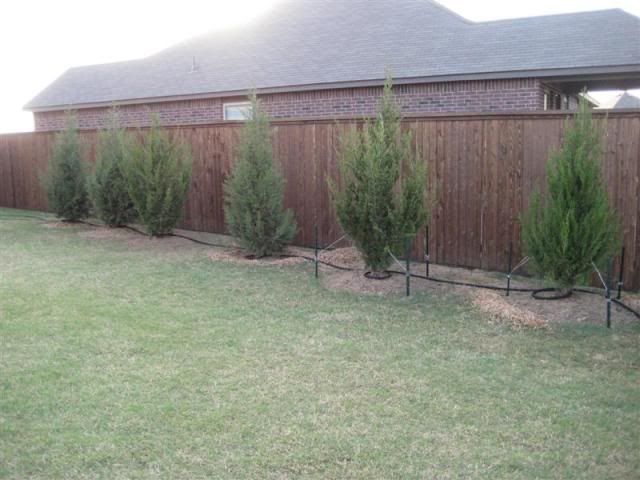
Canaerti junipers:
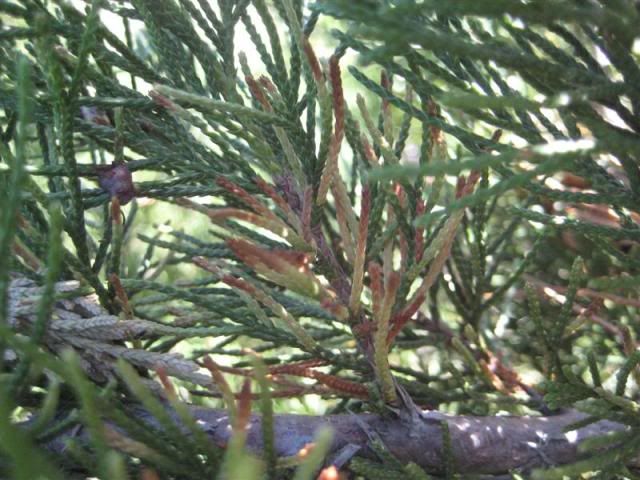
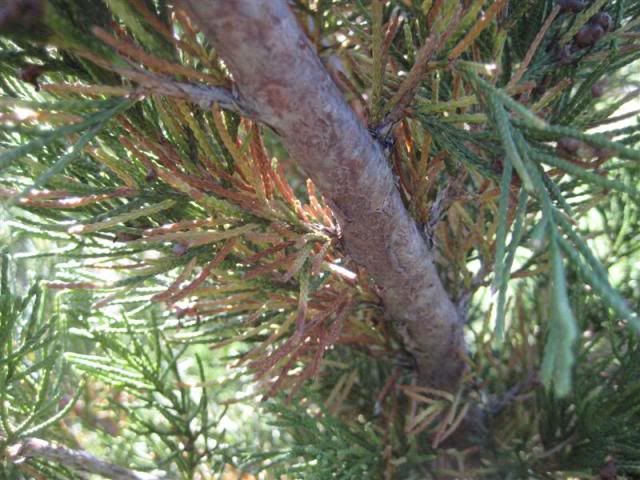
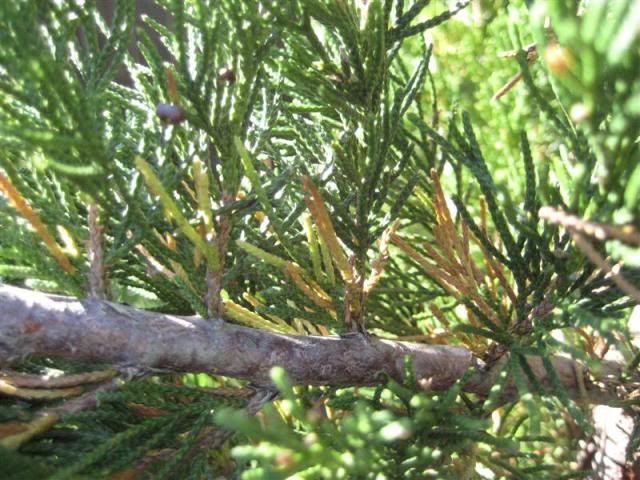
Keteleeri junipers
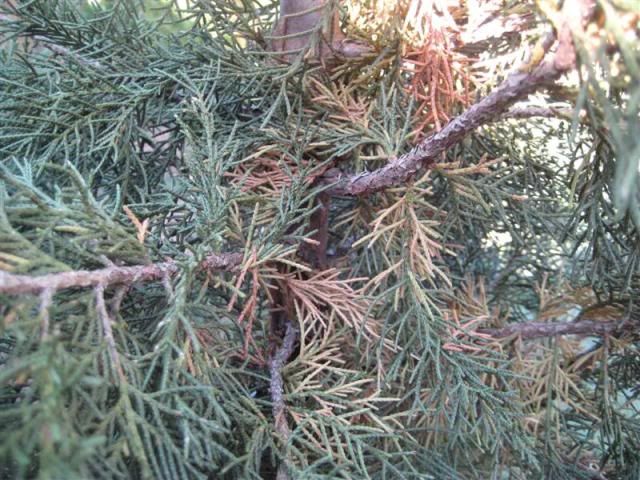
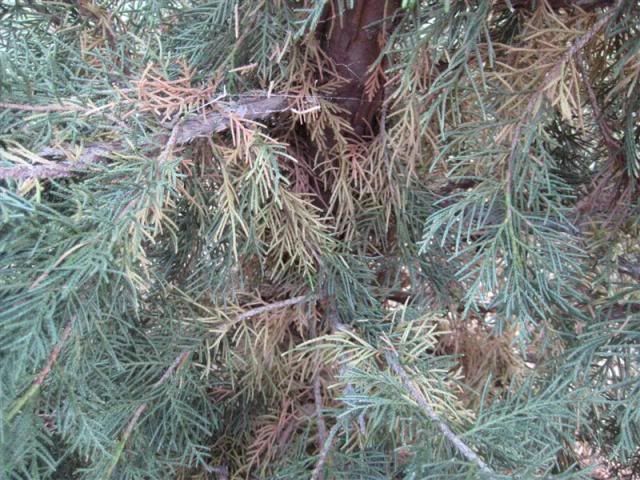

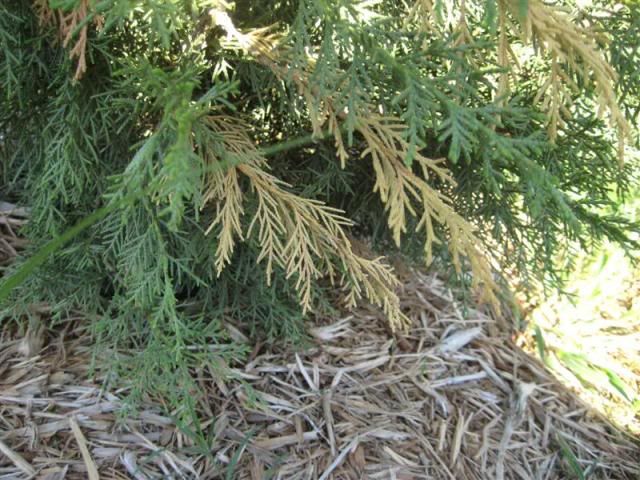
Last October, my husband and I completed a big landscaping project in our backyard (50 trees and shrubs!), and the anchors of the landscape design are the 14 juniper trees (6-7 feet tall) that we’ve planted in various locations. We have 3 varieties: canaerti, keteleeri, and spartan.
First, I’ll explain the issues we’re having. The canaerti junipers have cedar-apple rust, which we didn’t realize when we bought them. We waited for the slimy orange galls to dry up, and earlier this week we cut off as many of the large ones as possible. In the next month or two, we’re planning to spray them with fungicide to kill off the remaining fungus. This is not the primary issue we’re concerned with, however.
While pruning off the rust galls, I noticed a lot of brown needles at the centers of all the trees (canaerti, keteleeri, and spartan). I’m not sure how much of this is normal shedding versus some other problem that needs to be corrected. The appearance of this browning varies according to juniper variety.
Here’s some background in case it helps:
These were B&B trees that were originally grown in some kind of clay soil mixture. We dug 4-foot-wide holes for each juniper and backfilled with native clay soil (amended with haydite to help aerate the soil & absorb excess moisture). At the time, we thought we were “planting high,” but after planting, I read how important it is to remove extra soil at the base of the trunk. Once I’d removed 3-4 inches of soil at the base of each, the trees were planted right at grade.
The trees seemed to do well over the winter. This March we noticed some fairly minor instances of twig die-back, which I pruned about a month ago. Out of the 14 trees we planted, 1 spartan juniper died and we have replaced it with a new canaerti.
Since planting these trees last fall, I’ve been using a moisture meter to monitor the soil and only watering when they dried out. In the past few weeks, we’ve had quite a bit of rain (around 5 inches), so I haven’t watered them at all. Our last rain was 5 days ago, and the root balls still register as moist with some parts of the surrounding soil still at saturated level. The clay soil obviously doesn’t dry out very quickly.
In search of answers about the brown needles at the centers of the trees, I called 3 different places this morning: the original nursery, another nursery we bought plants from, and the master gardener/county extension office. As you can imagine, I received a number of opinions:
- Could be normal shedding due to lack of light at center of trees.
- Could be normal die-off from the harsh winter temperatures. Shake out the dead needles to prevent fungus.
- Could be insects, but probably too early for that. Shake needles onto white paper to see if anything appears. (I tried this, but didn’t see any evidence of insects.)
- Could be cercospora blight, which starts at the center and bottom of junipers and moves outward. Treat with fungicide. (I actually researched this last night, and found a K-State publication that said all 3 varieties are very resistant to cercospora.)
- Could be too much water due to high rainfall. One nurseryman said to dig up junipers, raise them above grade, and change the soil. The other nurseryman said not to disturb them if they’ve been in the ground for a while, and that we shouldn’t amend the soil because the trees have to adapt to it. He recommended removing the mulch during wet spring season to help it dry out.
I think most of these are valid possibilities. The problem is, how do I track down the right answer -- and quickly? We have a significant financial investment in these trees, not to mention all the backbreaking labor required to plant them. I don’t want to let this issue go on too long and risk losing them.
If it turns out to be a moisture problem, I’m considering digging them up (my husband will have to move them because they’re VERY heavy) and replanting them at least 4 inches above grade. I really don’t want to do this, but I may desperate enough at this point. If we do this, do you think it would be advantageous to create a raised bed with amended soil that will stay drier than the native clay?
I could really use your opinions (the more the better!) on how we should move forward at this point. I’ve posted some photos below in case it helps. Note that the first photo shows one row of junipers containing all 3 varieties. Photos #2-4 show the browning within the canaerti junipers, and photos #5-8 show the browning within the keteleeri junipers.
Thanks in advance!
Angela
===========
Row of mixed junipers:

Canaerti junipers:



Keteleeri junipers








